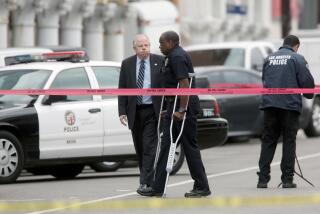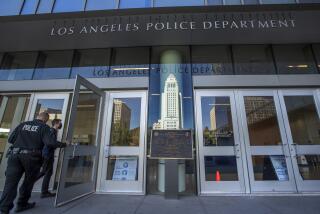Officer Accepts Plea Bargain in Driver’s Shooting
- Share via
An LAPD officer who shot an unarmed motorist in the back after a dispute over a traffic ticket pleaded no contest Wednesday to a felony charge of firing at an occupied motor vehicle.
Prosecutors said Ronald Orosco, 31, will receive from six months to seven years behind bars when he is sentenced Oct. 29. Without the plea bargain, he could have received 25 years to life in prison if convicted.
For the record:
12:00 a.m. Aug. 31, 2001 FOR THE RECORD
Los Angeles Times Friday August 31, 2001 Home Edition Part A Part A Page 2 A2 Desk 1 inches; 29 words Type of Material: Correction
District attorney’s office--A story Thursday incorrectly identified John Gilligan as head of the Los Angeles County district attorney’s Justice System Integrity Division. He is assistant head deputy.
The case is the second this year in which a Los Angeles police officer has been convicted in connection with an on-duty shooting. Officer Nino Durden, a key figure in the department’s corruption scandal, confessed in federal court that he shot an unarmed man and planted a gun on him in 1996.
However, prosecutions of Los Angeles County law enforcement officers for on-duty shootings are rare and convictions even more infrequent.
Earlier this month, the L.A. County district attorney’s office declined to prosecute LAPD Officer Edward Larrigan in the fatal 1999 shooting of a mentally ill homeless woman who was carrying a screwdriver. Before the new cases, the last local conviction of an on-duty officer occurred in 1982 when a Los Angeles County sheriff’s deputy served eight months for shooting a pregnant woman who was carrying an unloaded rifle.
Orosco, who had been indicted by the Los Angeles County Grand Jury, will lose his job at the 77th Street station, where he has been on unpaid leave since October, LAPD officials said Wednesday.
Orosco wounded retired aerospace worker Charles Beatty, 66, in June 2000, after pulling him over at the corner of Central and Florence avenues for allegedly crossing the yellow line in the road.
Prosecutors said Orosco and Beatty got into a heated argument over the traffic ticket and that the officer lost his temper and fired when Beatty tried to drive away after receiving the ticket. Orosco’s partner, Gorgonio Medina, did not fire his weapon.
William J. Hadden, Orosco’s attorney, has disputed the account, saying his client shot Beatty because he feared for his life.
Beatty was treated at County-USC Medical Center for a bullet wound in the back.
In September, the grand jury indicted Orosco on charges of assault with a deadly weapon and firing into an occupied vehicle. The grand jurors alleged that the officer “willfully, unlawfully and maliciously” fired at Beatty’s vehicle. Orosco, who had been an LAPD officer for five years at the time of the shooting, originally pleaded not guilty to the charges.
Orosco changed his plea Wednesday morning before Los Angeles Superior Court Judge Williams Pounders. In exchange for the plea, prosecutors dropped the assault charge.
John Gilligan, head of the district attorney’s Justice System Integrity Division, said the plea arrangement was a good deal because a jury’s reaction to an officer’s testimony is too unpredictable.
“Juries give the benefit of the doubt to police officers,” he said. “You just cannot underestimate their willingness not to second-guess an officer who testifies he was in fear for his life.”
Defense attorney Hadden said he believed his client was overcharged and did not want to risk being convicted by a jury and receiving a lengthy prison sentence.
“It’s a tough climate for police officers to be tried,” said the Santa Monica attorney. “If the jury found that one shot was out of line, he gets a ton of mandatory time. That makes going to trial on this kind of case absolutely frightening.”
On June 14, 2000, Officers Orosco and Medina, working in plainclothes and in an unmarked car, were stopped at a traffic light talking to a transient when Beatty pulled up behind them. After waiting through several light changes, Beatty, unaware that Orosco and Medina were officers, became impatient, drove around them and made an illegal left turn, said Deputy Dist. Atty. Hector Guzman.
When the officers pulled him over and issued a ticket for the maneuver, Beatty complained. He admittedly became belligerent, said Guzman, who prosecuted the case. But Beatty complied with the officers’ orders and was given permission to leave after he accepted the ticket, Guzman said.
At that point, the prosecutor said, the pair continued to exchange remarks. Beatty said something that prompted Orosco to decide to arrest him for disturbing the peace or challenging an officer to a fight, Guzman said.
Beatty told prosecutors that Medina grabbed Beatty’s arm to pull him out of his car. Beatty, according to Guzman, saw Orosco reach for his service pistol and fled in fear that he was about to be shot.
Guzman said Orosco shot through the driver’s rear side window from two feet away, striking Beatty in the back. He fired three more shots, the last from about 50 feet away as Beatty’s car was turning a street corner.
“Mr. Orosco lost his temper,” Guzman said. “He was angry. Mr. Beatty left the scene, and that did not please Mr. Orosco.”
Hadden said Orosco and Medina were holding onto Beatty when the motorist pressed the gas pedal, leading Orosco to believe he was going to be dragged into traffic. That’s when he began shooting, he said.
“Officer Orosco felt that at the time he fired rounds, his life was in danger and he was doing what was necessary to protect himself and his partner,” Hadden said.
Dist. Atty. Steve Cooley said the case represents “a historic breakthrough in Los Angeles County law enforcement.”
“It underscores the effectiveness of the . . . roll-out team,” Cooley said.
The conviction is the first for the newly revived program in the district attorney’s office, which sends prosecutors to the scene of every shooting involving a police officer.
The roll-out program was terminated in 1995 but restored five years later after allegations that LAPD officers had covered up unjustified shootings.
Guzman said it is critical for prosecutors to immediately report to the scene of officer-involved shootings and for the district attorney’s office and the Police Department to work together to deal with possible police misconduct.
Cmdr. Jim McMurray, head of the LAPD Internal Affairs Division at the time, said Wednesday that successful prosecution of the Orosco case should help restore public trust in the LAPD after the Rampart corruption scandal.
He called the case important because the department doesn’t want citizens thinking “that if you have a dispute with an officer that the outcome will be that you will get shot.”
Beatty had filed a civil suit in June against Orosco and the city, alleging violation of civil rights, assault and battery, and emotional distress. His attorney, John Sweeney, is seeking a damage award of between $5 million and $10 million. The bullet in still in Beatty’s back, Sweeney said.
“Now that Orosco has pleaded no contest, the city is clear to settle this case . . . and to make Mr. Beatty whole again,” the lawyer said.
Beatty declined comment but said through Sweeney that he is satisfied with the disposition of the case and is looking forward to putting this “ugly chapter” behind him.
More to Read
Sign up for Essential California
The most important California stories and recommendations in your inbox every morning.
You may occasionally receive promotional content from the Los Angeles Times.








